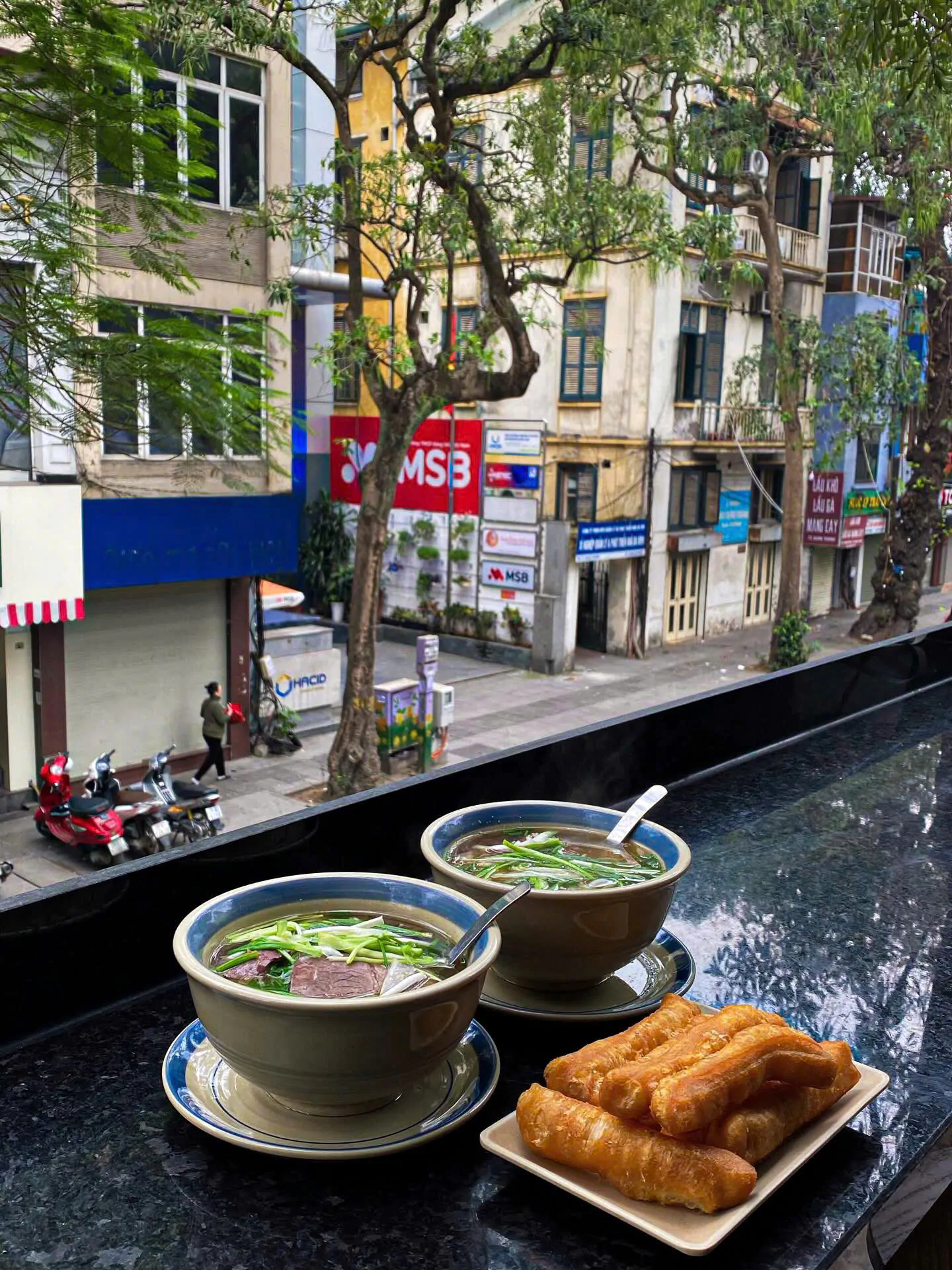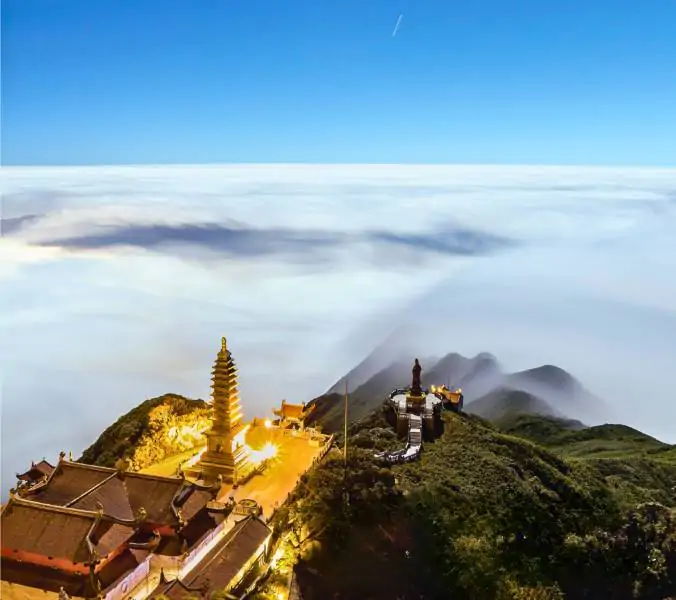Contents
The Presidential Palace in Hanoi stands as a testament to Vietnam’s rich history and architectural heritage. Situated in the heart of the city, this iconic site is not only a symbol of political significance but also a cultural landmark that attracts thousands of visitors each year. This comprehensive guide by Vietnam Discovery Travel will provide you with essential information you need to know before visiting the Presidential Palace, delve into its intriguing history, admire its remarkable architecture, and take a closer look at the must-see attractions within the palace complex.
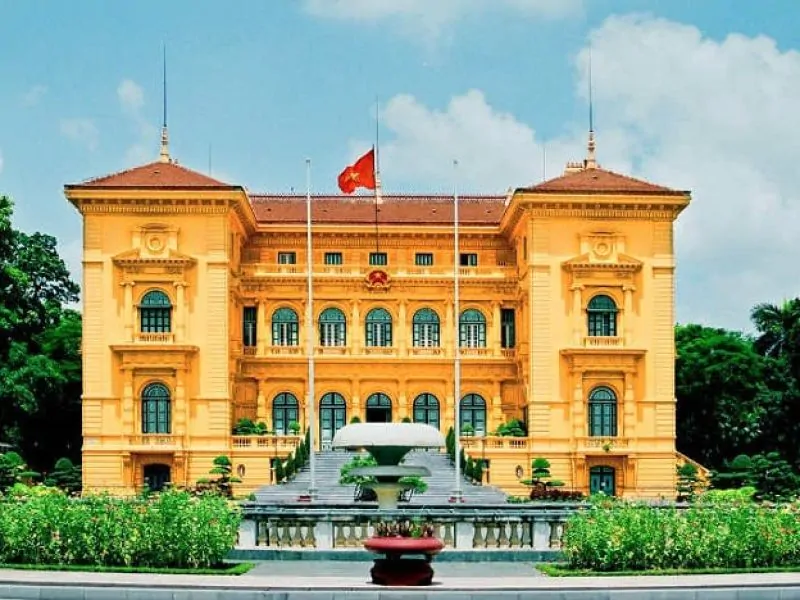
1. Essential Information for Tourists Visiting the Presidential Palace
The Presidential Palace is part of the Presidential Palace Historical Site, where President Ho Chi Minh lived and worked from December 19, 1954, to September 2, 1969. As a designated special national relic, the complex serves as a museum showcasing President Ho Chi Minh’s life. While the Presidential Palace itself is not open to tourists, the adjacent house where Ho Chi Minh resided and the surrounding grounds remain accessible to visitors.
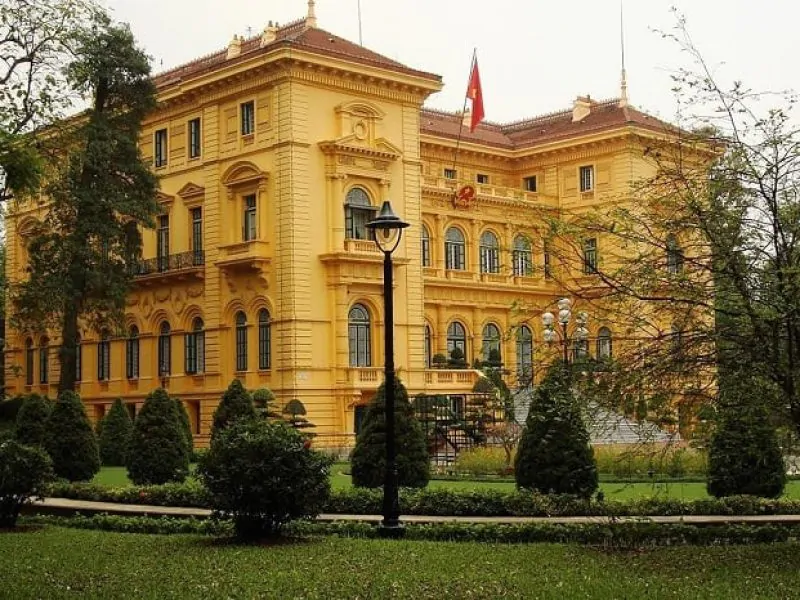
Location
The Presidential Palace is located in Ba Dinh District, Hanoi, the capital city of Vietnam. Specifically, it can be found at:
Location: No. 2, Hung Vuong Street, Ngoc Ha Ward, Ba Dinh District, Hanoi, Vietnam
Opening Hours
The Presidential Palace and its surrounding complex are open to visitors during the following hours:
- Monday to Friday: 7:30 AM – 11:00 AM; 1:30 PM – 4:00 PM
- Saturday and Sunday: 7:30 AM – 11:00 AM
Please note that the site may be closed on public holidays or during special events, so it’s always a good idea to check in advance.
Entrance Fees
Visiting the Presidential Palace complex requires an entrance fee. The current prices are as follows:
- Adults: 40,000 VND (approximately $1.70 USD)
- Children: 20,000 VND (approximately $0.85 USD)
- Students: 10,000 VND (approximately $0.40 USD) with a valid student ID
Tickets can be purchased at the entrance gate.
How to Get There
The Presidential Palace is conveniently located in the central part of Hanoi, making it easily accessible by various modes of transportation:
- By Taxi or Grab: The quickest and most comfortable way to reach the palace is by taxi or using the Grab app. A ride from the Old Quarter to the palace usually takes about 10-15 minutes.
- By Bus: Several public buses stop near the Presidential Palace. The most common bus routes are 9, 22, and 32. Ask the driver to drop you off at the “Ho Chi Minh Mausoleum” stop, which is a short walk from the palace.
- By Bicycle or Motorbike: For those who prefer a more adventurous mode of transport, renting a bicycle or motorbike is a popular option. There are parking areas near the entrance where you can safely leave your bike.
2. History of the Presidential Palace in Hanoi, Vietnam
Colonial Beginnings
The history of the Presidential Palace dates back to the early 20th century when Vietnam was under French colonial rule. Designed by French architect Auguste Henri Vildieu, the palace was constructed between 1900 and 1906 as the official residence of the French Governor-General of Indochina. Its grand design and opulent structure reflect the architectural style of the French Renaissance, making it one of the most impressive colonial buildings in Vietnam.
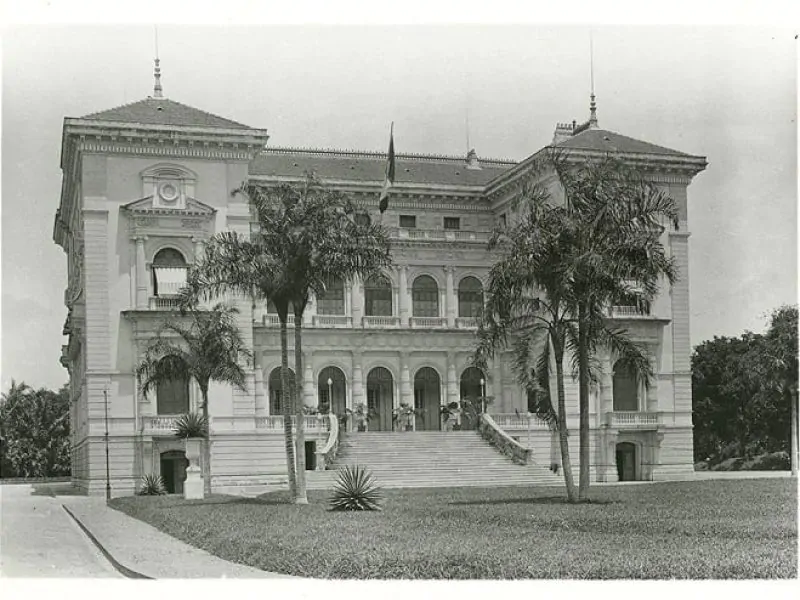
Post-Colonial Era
After Vietnam gained independence from France in 1954, the palace was repurposed as the official residence of the President of the Democratic Republic of Vietnam. However, Ho Chi Minh, the nation’s first president, chose not to live in the palace, opting instead for a more modest lifestyle. He only used the palace for official receptions and meetings, while residing in the nearby wooden stilt house, which is now a significant part of the complex.
A Symbol of Unity and Independence
Today, the Presidential Palace stands as a symbol of Vietnam’s journey to independence and unity. It has witnessed numerous historic events and continues to play a vital role in the country’s political and cultural landscape. The palace is not only a reminder of Vietnam’s colonial past but also a celebration of its resilience and determination to achieve sovereignty.
3. Remarkable Architecture of the Presidential Palace
French Renaissance Style
The Presidential Palace is a masterpiece of French Renaissance architecture, characterized by its symmetrical design, intricate details, and grandiose appearance. The building is painted in a distinctive mustard yellow, a color that is both striking and symbolic, representing the power and prestige of the French colonial administration. The palace’s exterior features elegant arches, balconies, and ornamental columns, all of which showcase the architectural grandeur typical of the Renaissance period.
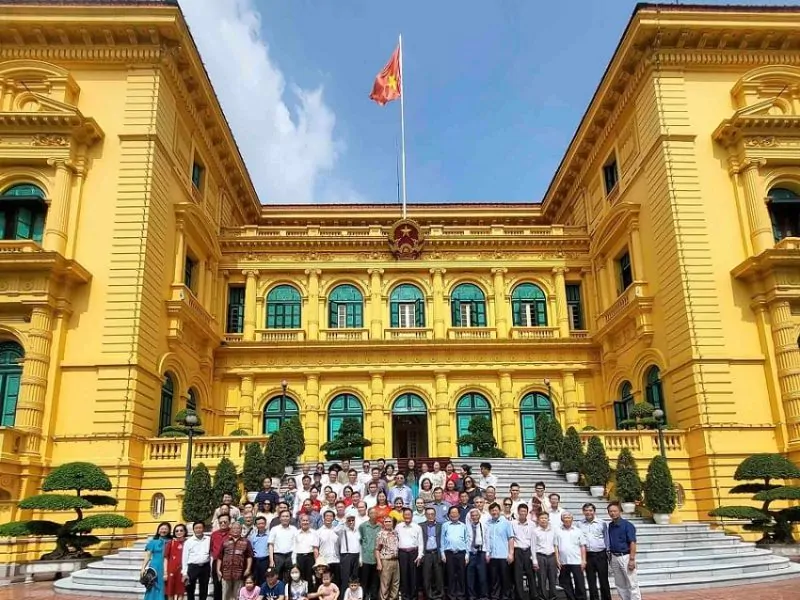
Lush Surroundings
The palace is set amidst lush gardens and tree-lined avenues, adding to its majestic aura. The meticulously maintained gardens feature a variety of indigenous and exotic plants, creating a serene environment that contrasts with the bustling city outside. The landscape architecture, with its carefully planned pathways and water features, enhances the palace’s overall aesthetic appeal.
Interior Elegance
While the interior of the Presidential Palace is not open to the public, it is known to be equally impressive. The lavishly decorated rooms, with high ceilings, ornate chandeliers, and fine European furnishings, reflect the opulence that was typical of colonial-era residences. The interior design seamlessly blends French elegance with traditional Vietnamese elements, creating a space that is both culturally significant and historically relevant.
4. Exploring the Presidential Palace Complex: What to See Inside
The Presidential Palace complex is more than just the main building; it encompasses several other historically significant structures and picturesque spots that offer visitors a deeper insight into the life and legacy of Ho Chi Minh, as well as the cultural heritage of Vietnam.
4.1. Wooden Stilt House
The Wooden Stilt House, located within the palace grounds, is one of the most important sites in the complex. This humble dwelling was where President Ho Chi Minh lived and worked from 1958 until his passing in 1969. The stilt house is a simple two-story structure, inspired by the traditional homes of ethnic minorities in the northern mountains of Vietnam.
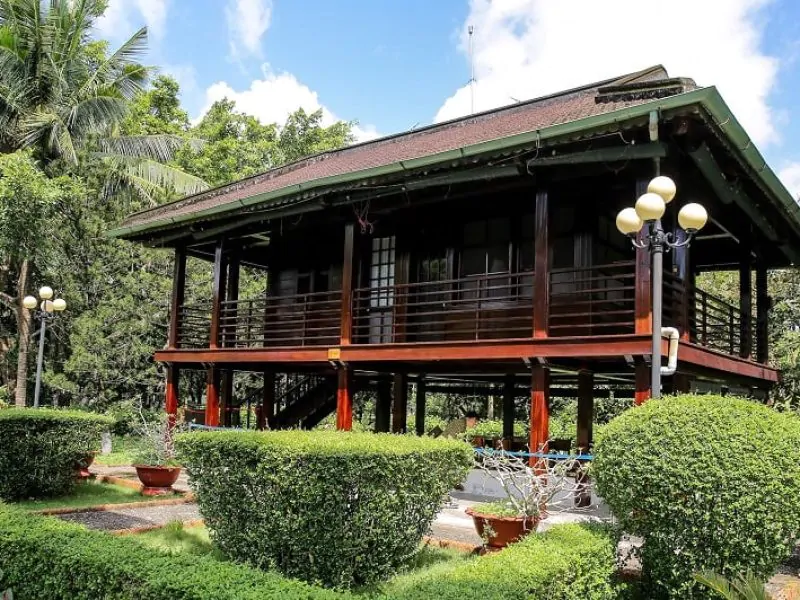
Features:
- The house consists of two rooms: a bedroom and a study, both furnished modestly with basic wooden furniture.
- Below the stilt house, there is an open area where Ho Chi Minh used to receive visitors and conduct meetings.
- The surrounding garden is filled with fruit trees, flowers, and a small pond, creating a peaceful and reflective environment.
4.2. House No. 67
House No. 67 holds significant historical value as it was where President Ho Chi Minh spent the final days of his life. This house was named after the year 1967 when it was built to serve as a more secure shelter during the American bombing raids.
Features:
- The house has been preserved exactly as it was during Ho Chi Minh’s time, with his personal belongings, books, and furniture still in place.
- Visitors can see the simple bed where Ho Chi Minh rested, his desk, and other items that offer a glimpse into his daily life.
- A visit to House No. 67 provides a poignant reminder of the leader’s dedication and the challenges he faced during the war years.
4.3. Uncle Ho’s Fish Pond
Uncle Ho’s Fish Pond is another charming feature of the palace complex. This tranquil pond, located near the stilt house, was one of Ho Chi Minh’s favorite spots for relaxation and contemplation.
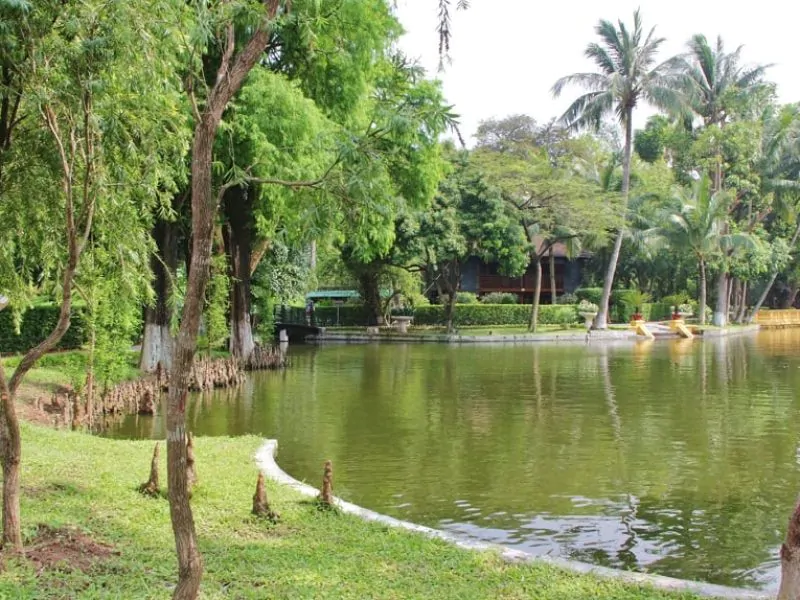
Features:
- The pond is home to a variety of fish, which Ho Chi Minh personally fed each day. Visitors can often see the fish swimming close to the surface, adding to the serene atmosphere of the area.
- The pond is surrounded by lush greenery, including bamboo groves and flowering plants, making it a peaceful retreat within the palace grounds.
- A small bridge crosses the pond, offering picturesque views and a perfect spot for reflection.
4.4. Mango Street
Mango Street is a beautiful pathway lined with mango trees that leads from the main gate of the complex to the Wooden Stilt House. This picturesque street is named after the mango trees that provide shade and add to the natural beauty of the area.
Features:
- The trees along Mango Street are more than just a scenic attraction; they hold historical significance as they were planted during Ho Chi Minh’s time.
- Walking along this path, visitors can enjoy the peaceful surroundings and the sweet scent of mangoes when they are in season.
- Mango Street is an ideal spot for photography, offering a perfect blend of natural beauty and historical ambiance.
4.5. House No. 54
House No. 54 is another important site within the Presidential Palace complex. Before moving to the Wooden Stilt House, Ho Chi Minh lived and worked in this house from 1954 to 1958.
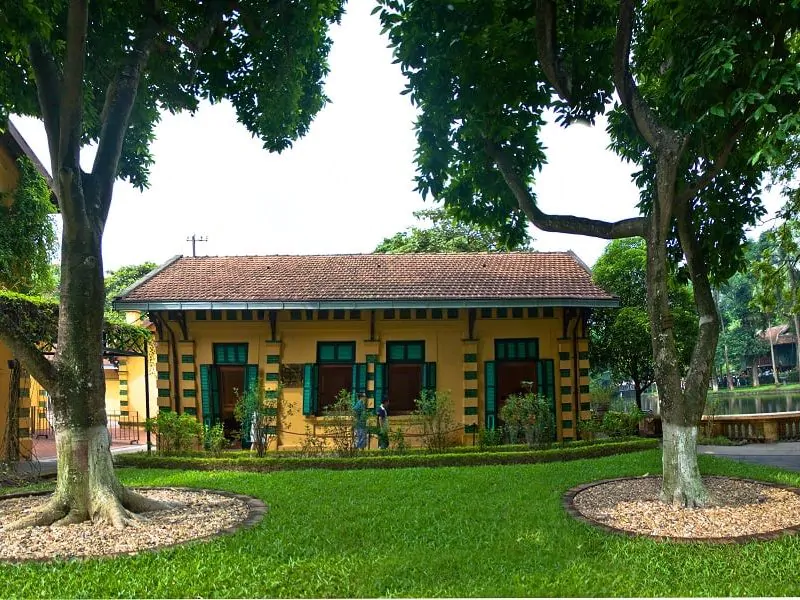
Features:
- House No. 54 is a simple, one-story building that reflects Ho Chi Minh’s preference for a modest lifestyle.
- The house contains several rooms, including a bedroom, a dining room, and a study, all furnished with basic wooden furniture.
- Visitors can see Ho Chi Minh’s personal belongings, including his writing desk, typewriter, and books, which provide insight into his daily life and work.
4.6. Lush Green Garden
The gardens surrounding the Presidential Palace are a highlight of the complex, offering a peaceful retreat from the hustle and bustle of Hanoi. The lush greenery and carefully maintained landscape create a serene environment that complements the historical significance of the site.
Features:
- The gardens are filled with a variety of plants, including rare species of flowers, trees, and shrubs. The diverse flora creates a vibrant and colorful setting throughout the year.
- Several walking paths wind through the gardens, allowing visitors to explore the area at their own pace and enjoy the natural beauty.
- The garden also features several statues and monuments dedicated to Ho Chi Minh, adding to the cultural and historical importance of the site.
5. Conclusion
The Presidential Palace in Hanoi is more than just a historic building; it is a symbol of Vietnam’s journey through colonialism, independence, and national pride. The complex offers visitors a unique opportunity to explore the life and legacy of Ho Chi Minh, one of the most revered leaders in Vietnamese history. From the grand architecture of the palace itself to the humble stilt house and tranquil gardens, every aspect of the site reflects the rich cultural heritage of Vietnam.
Whether you’re a history enthusiast, an architecture lover, or simply a curious traveler, the Presidential Palace is a must-visit destination in Hanoi. Be sure to take your time exploring the various sites within the complex, and immerse yourself in the history and beauty of this remarkable landmark. For more details or to plan your visit, connect with Vietnam Discovery Travel on WhatsApp for personalized guidance and insider tips.













